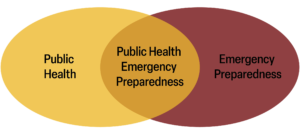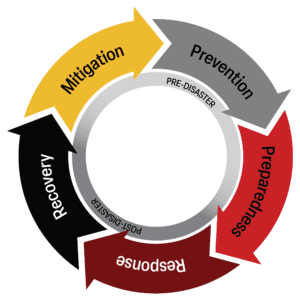Epidemiology
The study and analysis of the patterns, causes, and effects of health and disease conditions in defined populations. Epidemiology is the cornerstone of public health, and shapes policy decisions and evidence-based practice by identifying risk factors for disease and targets for preventive healthcare.
Public health
The science and art of promoting health, preventing disease and improving the quality of life of a population through organized efforts of society.
Disaster epidemiology
The epidemiologic analysis of disaster activities according to the different phases of disasters, and the short- and long-term adverse health effects of disasters on the population.
Emergency preparedness
Preparedness is defined by Department of Homeland Security /Federal Emergency Management Agency as "a continuous cycle of planning, organizing, training, equipping, exercising, evaluating, and taking corrective action in an effort to ensure effective coordination during incident response." This cycle is one element of a broader National Preparedness System to prevent, respond to, and recover from natural disasters, acts of terrorism, and other disasters.
Public health emergency preparedness
The capability of the public health and health care systems, communities, and individuals, to prevent, protect against, quickly respond to, and recover from health emergencies, particularly those whose scale, timing, or unpredictability threatens to overwhelm routine capabilities. Preparedness involves a coordinated and continuous process of planning and implementation that relies on measuring performance and taking corrective action. Public health preparedness uses the phases of emergency management to plan and implement interventions that aim to create the highest level of health for the greatest number of people.

Environmental health
The branch of public health concerned with all aspects of the natural and built environment impacting human health.
Resilience
The ability of a Tribal Nation to cope with an emergency, to rebuild, and to learn from an experience to recover readily and bounce back stronger, which ultimately strengthens Tribal sovereignty, builds healthier communities, and a better future for upcoming generations.
Capacity
Capacity refers to the ability or potential that an actor has for responding to an event that exceeds everyday resources. Actors may be Tribal Nations, groups, organizations, public health or emergency management systems, or national governments.
Disaster phases
Disasters and emergency management has commonly followed the all‐hazards model and divided a disaster or emergency into five phases: mitigation, prevention, preparedness, response, and recovery. The first three phases (mitigation, prevention, preparedness) occur before a disaster or emergency event; the latter two (response and recovery) during or after the disaster.
- Mitigation involves those activities and policies that are designed to prevent or lessen the effect of an emergency event and reduce the vulnerability of high‐risk areas or groups.
- Prevention focuses on preventing human hazards, primarily from potential natural disasters or terrorist (both physical and biological) attacks. Preventive measures are designed to provide more permanent protection from disasters; however, not all disasters can be prevented. The risk of loss of life and injury can be limited with good evacuation plans, environmental planning and design standards.
- Preparedness is planning how to respond in an emergency and involves the development of system‐level capacities for emergency response.
- Response is the immediate reaction to an emergency in which primary responders seek to save and safeguard lives, minimize property damage and improve the potential for better recovery.
- Recovery involves the restoration of services, systems and livelihoods following the disaster. The recovery phase can be divided into short‐term and long‐term phases. Short‐term recovery corresponds to, what is sometimes considered, the relief phase in which local community systems are being returned to a minimum level of operations. The long‐term recovery phase corresponds to what can be considered the rehabilitation or reconstruction period. It can last for months to years as the disaster area begins to return to its previous condition. Depending on the severity, disasters may have irreversible permanent effects on populations and communities.
Core Functions of a Tribal Epidemiology Center
Learn more about the Core Functions of a Tribal Epidemiology Center.